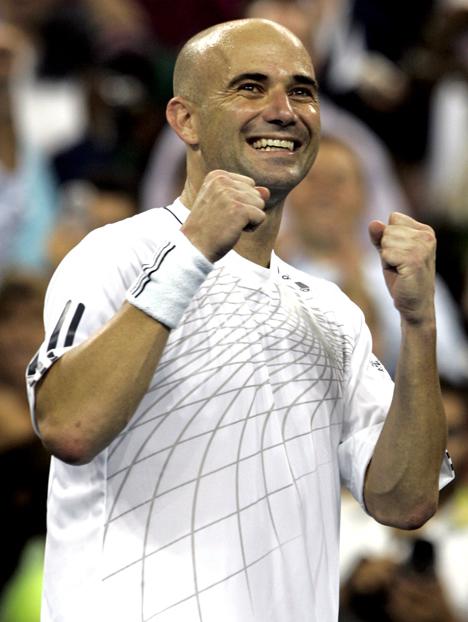Agassi delays retiring; wins first round match
Aug 30, 2006
Last updated on May 12, 2016 at 04:09 a.m.
NEW YORK – Andre Agassi’s eyes were red and filled with tears as he stood at the baseline, one point from winning his first match at his last U.S. Open. A record crowd was standing, trying to will him to victory.
An hour or so earlier, Agassi’s eyes were looking at the end of his career. Now, though, he’ll get to go out on court once again.
Agassi forced his 36-year-old body around Arthur Ashe Stadium for three and a half hours Monday night and into Tuesday morning, until he beat Andrei Pavel of Romania 6-7 (4), 7-6 (8), 7-6 (6), 6-2 to reach the second round.
“To be out there for that long,” Agassi said, “gives me hope for what I can push myself through.”
Get The Daily Illini in your inbox!
With fans still buzzing about his win, play resumed Tuesday afternoon after a rain delay of about three and a half hours.
A full slate of major title winners was scheduled for action, including top-seeded Amelie Mauresmo, two-time French Open champion Rafael Nadal, and 2001 U.S. Open winner Lleyton Hewitt.
Maria Sharapova and James Blake were among those scheduled to play at night.
Agassi’s victory highlighted the first day at the Open.
There were moments, though, when it looked as if Agassi would be bidding adieu for good. After he lost the first set, for example. And especially when he fell behind 4-0 in the third set, causing his wife, former star Steffi Graf, to pace a bit.
Yet that’s when Agassi found the energy and shots to reverse things. Coincidence or not, he went on a five-game run shortly after motioning to his coach, Darren Cahill, to bring him more tightly strung rackets. It also was around that time that Pavel – a 32-year-old ranked 77th who hadn’t played a hard-court match since March – was visited by a trainer because of stomach cramps and diarrhea.
“That was a big turnaround set,” Agassi said.
He pulled it out despite needing cortisone shots for a bad back. Despite not having much match preparation, entering the day only 8-7 in 2006. And despite facing a player who was able to match him stroke-for-stroke over long stretches.
Next for Agassi is a match Thursday against eighth-seeded Marcos Baghdatis of Cyprus, a 21-year-old player who reached the Australian Open final and Wimbledon semifinals this year. He should be a sterner test than Pavel.
“Such a talent,” Agassi said. “One of those guys you’d pay to go watch.”
He should know. Agassi won the Open in 1994 and 1999, part of his collection of eight Grand Slam titles, and was the runner-up four times, including last year. When Agassi won that first U.S. Open championship, his blond hair was long and tucked under a ballcap, his shirt was a loud purple, and he wore a pinkie ring and dangling earring.
Hard to believe that same person was under the lights Monday. Look at Agassi now: shaved head, country-club-ready white outfit, and the beaded necklace that reads, “Daddy Rocks,” made by his son. Both of Agassi’s children were in the stands; in the fourth set, Graf was using a video camera, just like any parent on an outing with the kids. Agassi’s father was there, too, as was his brother, Phil.
“To not compete this year, not try to get myself right, not try to get myself through it, I would feel like I was quitting more than retiring,” he said. “As much pain as it’s been, it’s been worth it for me just to put myself in a position where I can have clarity in my own peace of heart, peace of mind in the decision I’m making, because I believe it affects more than just me.”
That sort of thinking might have helped him get to the third tiebreaker, then dominate the final set. It was a fitting way to cap a day that celebrated three of the sport’s most significant figures.
Before Agassi’s match, the U.S. Tennis Association rededicated its facility, naming it the Billie Jean King National Tennis Center. And Jimmy Connors was on the scene, too, coaching Andy Roddick to a victory and soaking in the adoration.
Roddick, who ended a 10-month title drought after teaming with Connors, joined four other past Open champions who reached the second round: Lindsay Davenport, Justine Henin-Hardenne, Svetlana Kuznetsova, and, of course, Agassi.
“I want to be here real bad, for the whole two weeks,” Agassi said. “I really want to leave my best stuff on the court. … I’m very proud of this day, and I’m glad it gets to happen again.”
After trotting back to a baseline for the prematch warmup, Agassi paused, glanced around the arena and took a deep breath. He knew, after all, this moment would arrive. It was time to take it all in.
Cameras flashed from the start, during warmups, between games, and between points.
And Agassi provided some picture-perfect moments, glimpses of his glorious past, of the player who’s won 60 singles titles. He used what was often considered his trademark, the hard-hit return, to gain the advantage.
“I didn’t anticipate it to be this difficult emotionally. You want to take it in because you know how special it is. You feel it,” Agassi said. “At the same time, you’ve got a top-notch job to do.”






